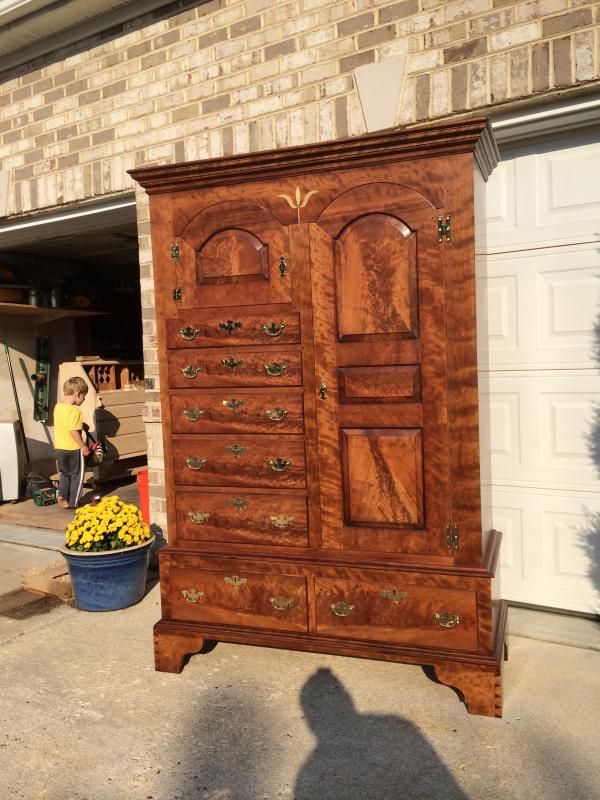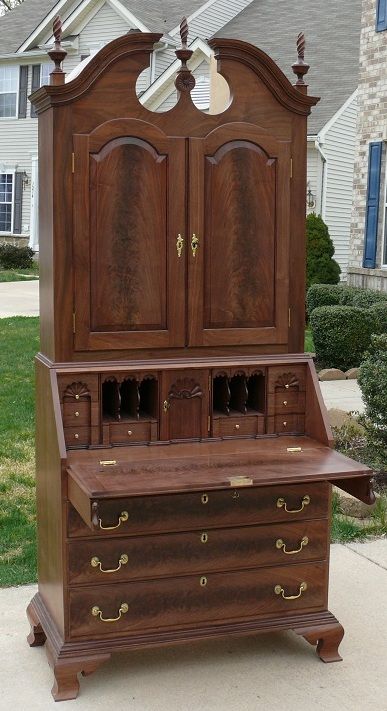Posts: 550
Threads: 0
Joined: Jul 2017
08-17-2017, 07:17 PM
(This post was last modified: 08-17-2017, 07:20 PM by FloridaRetiree.)
(08-17-2017, 07:03 PM)Dave Diaman Wrote: FloridaRetiree, you are right. Getting a vacuum set up is not as expensive as most people think. My first one was a $59 HVAC vacuum pump from Harbor Freight and a cheap premade vinyl bag. I looked at a bunch of different options for a bag but the premade vinyl ones are fairly inexpensive, come with everything you need in one package and are nearly indestructible. By the time I would have bought all the parts and pieces it was almost the same price and the bag would have not been nearly as nice. Sometimes there is just no replacement for good old contact cement though. I still haven't found a better material for applying laminate. On top of all that you will get a happy feeling from smelling all the fumes while you work with it.
HA HA HA! about the fumes.
Yes, no doubt, contact cement has its place in Adhesive World.
I had a large 10 degree back "vertical booth" and a dedicated pot and spray gun to apply it whenever needed.
However, and while talking about contact cement, I had a nice guy next-bay neighbor who specialized in custom building cheap particle board/mica furniture.
He got a bad glue batch and had to rebuild several built-ins because of de-lamination.
Even though he got some sort of settlement from the glue company (?) it almost put him out of business.
A laid back southeast Florida beach bum and volunteer bikini assessor.

Posts: 589
Threads: 0
Joined: Jan 2017
Location: Marina del Rey
I would never use contact cement for gluing plywood to plywood. Epoxy is a good choice.
Wood is good.
Posts: 3,215
Threads: 0
Joined: Jan 2006
How would you remove all the bubbles without a vacuum set up or an elaborate clamping set up?
Posts: 3,215
Threads: 0
Joined: Jan 2006
08-17-2017, 08:15 PM
(This post was last modified: 08-17-2017, 08:17 PM by Dave Diaman.)
(08-17-2017, 07:17 PM)I FloridaRetiree Wrote: HA HA HA! about the fumes.
Yes, no doubt, contact cement has its place in Adhesive World.
I had a large 10 degree back "vertical booth" and a dedicated pot and spray gun to apply it whenever needed.
However, and while talking about contact cement, I had a nice guy next-bay neighbor who specialized in custom building cheap particle board/mica furniture.
He got a bad glue batch and had to rebuild several built-ins because of de-lamination.
Even though he got some sort of settlement from the glue company (?) it almost put him out of business.
Ouch. The only thing I have ever had a problem with was epoxy. I suspect it had been frozen but I'm not sure.
I was watching an old timer in a shop I was working in once doing some lamination work with contact cement. He was spreading on the contact cement with a cigarette hanging lit in his mouth. All the while I'm watching glowing ash dangle. All the sudden the contact burst into flames. Without missing a beat the guy pulled his hat off, beat the fire out, put his hat back on and kept right on going like nothing happened. After I picked my jaw up off the floor I walked over to him and said "it looks like you have done that a time or two before". He just smiled around his cigarette and kept right on going.

Posts: 550
Threads: 0
Joined: Jul 2017
(08-17-2017, 08:15 PM)Dave Diaman Wrote: Ouch. The only thing I have ever had a problem with was epoxy. I suspect it had been frozen but I'm not sure.
I was watching an old timer in a shop I was working in once doing some lamination work with contact cement. He was spreading on the contact cement with a cigarette hanging lit in his mouth. All the while I'm watching glowing ash dangle. All the sudden the contact burst into flames. Without missing a beat the guy pulled his hat off, beat the fire out, put his hat back on and kept right on going like nothing happened. After I picked my jaw up off the floor I walked over to him and said "it looks like you have done that a time or two before". He just smiled around his cigarette and kept right on going.

Great story!

I always kept some two-part epoxy around the shop; one thin and the other thick -- until I learned how to make my own thick.
It had limited usage since it didn't like tight joints. Frankly I don't remember what all I used it for? Had to be something to utilize its great gap filling properties.
Was obviously worthless in a bag press application since here at sea level I was getting almost 15 lbs per square inch of uniform pressure, or a little over a ton per square foot.
That was painfully learned when I first tried veneering a curvilinear piece on a form. I thought the form was pretty strong but (as I remember) there was about six square feet of veneer, . . . so the press completely crushed the form and everything was ruined.
Dummy!
A hard way to learn not to include such a form within the vacuum.
A laid back southeast Florida beach bum and volunteer bikini assessor.

Posts: 3,215
Threads: 0
Joined: Jan 2006
I use a lot of cherry and walnut crotch wood. It almost always has cracks or voids in the crotch. I usually put a piece of tape on the bottom of the board over the crack and pour thin epoxy on top so it can flow through the entire board. With a little color in the epoxy it does a great job or covering up voids in wood. I built this cherry and walnut piece back when I was still working out of my garage and these crotches had quite a few voids in them. After the dye and fill it just looked like gum streaks in the cherry and almost disappeared completely in the walnut. Of course I also had to be really careful with my adhesives to make sure they didn't freeze too. I did a lot of work in that small space but don't miss it at all. It felt like I was working out of a closet.


Posts: 550
Threads: 0
Joined: Jul 2017
Posts: 3,215
Threads: 0
Joined: Jan 2006
I build and sell 30-40 period pieces a year. Since I moved into my new shop I build a kitchen now and then. I really don't like cabinetry though. I build some small pieces that are under $1k but probably half of my work would be similar in price to what your neighbors used to build. It pays the bills and allows me to do what I love for a living. Today I'm doing something something a little different. I'm making a small countertop using wait for it.......contact cement

Posts: 12,451
Threads: 0
Joined: Aug 2003
Location: Wapakoneta, OH
08-19-2017, 10:18 AM
(This post was last modified: 08-19-2017, 12:09 PM by fredhargis.)
Somehow "excellent" seems inadequate for those pieces, but I can't think of a word that works. Just really wonderful/awesome/nice/or something.
I started with absolutely nothing. Now, thanks to years of hard work, careful planning, and perseverance, I find I still have most of it left.
Posts: 550
Threads: 0
Joined: Jul 2017
(08-19-2017, 10:17 AM)Dave Diaman Wrote: I build and sell 30-40 period pieces a year. Since I moved into my new shop I build a kitchen now and then. I really don't like cabinetry though. I build some small pieces that are under $1k but probably half of my work would be similar in price to what your neighbors used to build. It pays the bills and allows me to do what I love for a living. Today I'm doing something something a little different. I'm making a small countertop using wait for it.......contact cement

Just went to your web site for the first time. Very very impressive.
How big is your shop and how many employees?
When the economy was booming (way-back-when) I had three other masters and four apprentices in a 4000sf shop.
Unlike you, and as "Captain Contemporary," I could not make it as a furniture designer and custom builder, even after having been published in two of the Fine Woodworking Biennial Design Books, so I gravitated to cabinetry.
Fortunately this is a very rich area and I hooked up with the best local interior designers who specialized in cost-no-hindrance projects. I soon specialized in doing things other shops could not do or would not attempt. We did some wild and crazy things and I have a great photo portfolio -- all analog unfortunately so can't show here. But, if you want to meet sometime we can share some adult beverages and have a good time comparing notes.

A laid back southeast Florida beach bum and volunteer bikini assessor.











